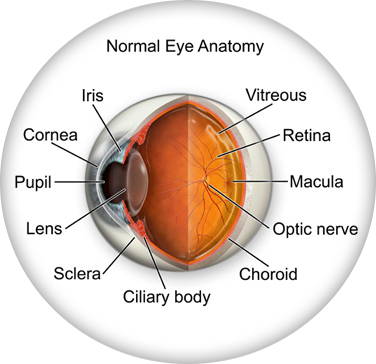
| CORNEA: | Transparent front layer of the eye; provides most of the eye's optical power. |
| PUPIL: | Variable-sized, circular opening in center of iris; appears as a black circle and it regulates the amount of light that enters the eye. |
| IRIS: | Pigmented structure lying behind cornea that gives color to the eye and controls the amount of light entering the eye by varying the size of black pupillary opening. |
| LENS: | Natural lens of eye; transparent structure that helps bring rays of light to focus on the retina. |
| RETINA: | Internal lining of the eye that converts what we see into neural impulses sent along the optic nerve for transmission back to the brain. Consists of many layers that include rods and cones. |
| MACULA: | Small, specialized central area of the retina responsible for the sharpest central vision. |
| VITREOUS: | Transparent gel that fills the space within the eyeball; located between the lens and the retina. |
| OPTIC NERVE: | Largest sensory nerve of the eye; carries impulses for sight from retina to brain. |
| SCLERA: | The white part of the eye; a protective fibrous layer that is the outer covering of the eyeball |
| CILIARY BODY: | A muscular ring under the surface of the eyeball; helps the eye focus by changing the len’s shape and also produces aqueous humor which is the fluid inside the eye that gives the eye its internal eye pressure. |
| CHOROID: | The vascular layer between the sclera and the retina; the blood vessels in the choroid help provide oxygen and nutrients to the eye. |
Recommended Link:
All About Vision: Eye Anatomy
